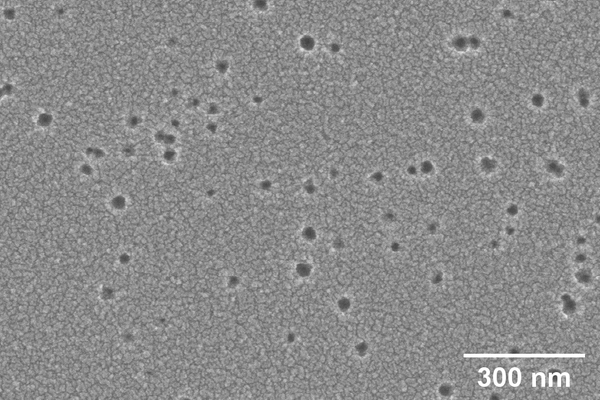Materials modification by ion beams
Ion beams can be used in a variety of ways to manipulate material properties. At the Tandem Laboratory we use ions in a wide range of energies, from low keV to several MeV, for many different applications.
If you want to order implantations or are interested in other services within ion beam modification of materials (IBMM), check our user access page.
keV ion implantations
We make use of keV ion implantations to change the electronic properties of materials. The most prominent example is the creation of specific dopant concentrations in semiconductors. This method is also used to produce Ohmic contacts. Ion implantations can even lead to the formation of nanoparticles with electronic or optical properties different from the bulk material.
We are currently developing a new low-energy ion implantation system with envisioned ion energies from 0.25-10 keV. This low-energy ion implanter (LEION) will be used for doping of 2D materials.

Scanning electron microscopy image of a polyimide sample that has been irradiated with a 3.25 MeV oxygen beam.
Nanostructure engineering
Energetic ions can create nanostructures in materials such as pores, hillocks or tracks. At the Tandem Laboratory, we among others study how keV ions can produce pores in membranes for potential filter applications.
Much research on nanostructure formation has been done in the GeV ion energy regime. We are now investigating to which extent MeV ions that require much smaller accelerators and other instrumentation can be used instead. As an example, we have used MeV ions to produce etchable tracks in polyimide membranes.
Ion irradiations
Besides precise tailoring of electronic and structural characteristics, ion irradiations can also be used to create damage. Irradiations can amorphize single-crystalline materials, which for example allows researchers to analyse their annealing behaviour. At the Tandem Laboratory, we also test radiation hardness of different materials and components as ion irradiations can effectively simulate high-radiation environments such as space or nuclear reactors.
Selected publications
Proton irradiation-induced cracking and microstructural defects in UN and (U,Zr)N composite fuels
Part of Journal of Materiomics, p. 906-918, 2024
- DOI for Proton irradiation-induced cracking and microstructural defects in UN and (U,Zr)N composite fuels
- Download full text (pdf) of Proton irradiation-induced cracking and microstructural defects in UN and (U,Zr)N composite fuels
Part of Nuclear Materials and Energy, 2023
- DOI for Impact of ion irradiation and film deposition on optical and fuel retention properties of Mo polycrystalline and single crystal mirrors
- Download full text (pdf) of Impact of ion irradiation and film deposition on optical and fuel retention properties of Mo polycrystalline and single crystal mirrors
Ion Track Formation and Nanopore Etching in Polyimide: Possibilities in the MeV Ion Energy Regime
Part of Macromolecular materials and engineering, 2023
- DOI for Ion Track Formation and Nanopore Etching in Polyimide: Possibilities in the MeV Ion Energy Regime
- Download full text (pdf) of Ion Track Formation and Nanopore Etching in Polyimide: Possibilities in the MeV Ion Energy Regime
Part of 2D Materials, 2023
- DOI for A contactless single-step process for simultaneous nanoscale patterning and cleaning of large-area graphene
- Download full text (pdf) of A contactless single-step process for simultaneous nanoscale patterning and cleaning of large-area graphene
Part of Nanotechnology, 2017

